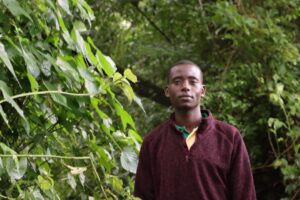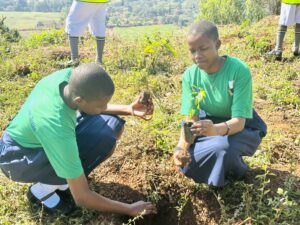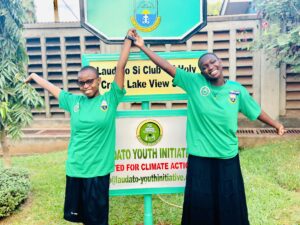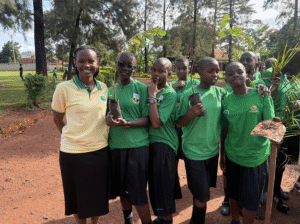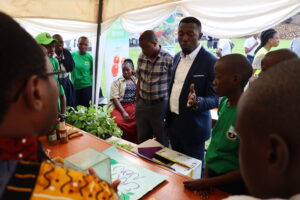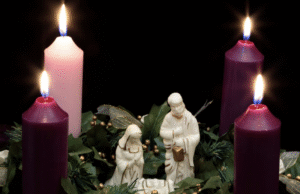By Ayebale Fred | Laudato Si’ LYI Media & Environmental Writer
Today’s Laudato Si’ Walk, organized by the Laudato Si’ Club of Divine Mercy S.S.S Kiko, was far more than just a nature hike—it was an immersive pilgrimage into God’s creation, a powerful lesson in ecological awareness, and an urgent call to action for young people to become true caretakers of our common home. One student shared,
“This pilgrimage has been a soul‑stirring journey through some of Fort Portal’s most scenic and sacred landscapes that I have always longed for”.
Participating in this nature walk in nature walk with our headteacher, Ms. Basemera Sharon and other eco‑leaders has changed me, he said, and I have discovered.
“Nature is not a place to visit. It is home.” — Gary Snyder
Despite intermittent sunshine, cloud cover, dew‑like showers, and even rain, our pilgrimage remained undeterred. We walked through the morning mist under the gentle hum of birdsong, feeling as though the earth itself was reciting a living psalm. The trail guided us past towering trees and lush greenery, to Amabere Ga Nyina Mwiru Caves, through Kalyango Hills, and along unspoiled plant life, some in full bloom.
“It was like walking through a painting,” said Mr. Daniel Rusahura, Patron of the Laudato Si’ Club. “Every step reminded us that creation is a gift, and we are its stewards.”

Feast for the Eyes and Soul
We began amid the vibrant flora of Divine Mercy Secondary School. The sunrise over the magnificent Rwenzori Mountains reflected on stunning water bodies such as Nyakasura Pond, Rwabikere, and Barama, filling us with reverence for nature’s pristine beauty.
Walking with the pearl of Fort Portal Tourism City
Our path led to a sparkling stream that wound through the Amabere Caves. We saw the Mabere caves famous for their limestone formations and associated local legends. The caves are known for the stalactites and stalagmites which are believed to resemble the breasts of a woman, and are named “Amabere” which means “breasts” in the local language. Bees buzzed busily among flowers, pollinating as they moved. We saw stalactites and stalagmites dripping calcium-rich water in the Amabere Ga Nyina Mwiru site:
“The place earns its name from a legend,” explained the guide: “Amabere Ga Nyina Mwiru” (“Breasts of Nyina Mwiru”) dripping ‘milk’ from the rocks, echoing the myth of the princess whose breasts flowed in the cave. Geologists clarify that these formations were created by mineral-rich water over millennia, forming serene columns and holy reminders of our connection to the creation story and the Mother Earth
Breathtaking Vistas and Ecological Gems
Climbing to hilltops, we were rewarded with sweeping views of Saaka and the hills surrounding it, Lake Kigere, Lake Nyabikere, Barama, and a landscape stretching in waves of green as far as the eye could see. The breeze carried the scent of wildflowers and birdcalls. “It’s in moments like these you feel creation speaking to you,” one mesmerized student noted.

Landmarks of Learning
We passed the iconic Mountain of the Moon University, reflecting on how similar Laudato Si’ clubs are nurturing ecological leadership in both schools. As a recent alumnus, I spoke passionately of how our journeys there prepared us for this walk of stewardship.
Sacred Stops and Spiritual Reflection
We reflected at Kalyango Hills, revered Amabere Ga Nyina Mwiru, and the peaceful grounds of the university. Later, we joined a moving ecological talk and a moment of prayer at Holy Cross Novitiate Lake Saaka. Br. Cleophas Kyomuhendo, C.S.C., welcomed us and said:

“The environment is not just background—it is a living testament to God’s creativity and care.”
In his encyclical Laudato Si’, Pope Francis calls on the youth to lead the ecological revolution.
“Young people have a new ecological sensitivity and a generous spirit, and some of them are making admirable efforts to protect the environment.” (Laudato Si’, 209) Let each one of you who participated return with a deeper love for the Earth and a stronger commitment to care for it because “The Earth is what we all have in common.”
Mindfulness, Bonding, and Reflection
Our pilgrimage inspired mindfulness, enabling us to fully inhabit each sight and sound: silence in awe, shared stories, curious questions, and laughter among new friends. “We were not just walking through nature,” said a student, “we were walking with nature.”

Capturing Creation’s Canvas
We carried cameras and open hearts. The images we captured—hills against stormy skies, reflective lakes, waterfalls—became living advocates for conservation. A student shared: “I captured the Saaka hills under a stormy sky—it felt like Jesus was present in the stormy sea.”
A Walk for Mother Earth
This pilgrimage was an act of thanksgiving—not only to observe creation but to embrace our responsibility to it. From a stormy dawn to a bright afternoon, nature taught us resilience and unity.
We concluded with prayer, joined by Laudato Youth, Ms. Basemera Sharon, Mr. Daniel, our headteacher, and club leaders under the open sky. We prayed in gratitude and hope that this walk would shape our daily lives—with awareness, appreciation, and action.

Final Reflection
The Laudato Si’ Walk was more than an event; it was a testament to ecological spirituality, communal strength, and environmental urgency. For the Laudato Si’ Club of Divine Mercy S.S.S Kiko, it marks a recommitment to Laudato Si’—to praise, protect, and preserve our common home.
“Everything is connected,” Pope Francis reminds us. Today, amid hills, waters, and stories, we felt it profoundly. We returned not just refreshed—but transformed: hearts open, minds inspired, and spirits grounded in gratitude.
Let this pilgrimage remind us all: every step in creation brings us closer to God—and closer to caring for our Earth.

Learn more about the Club https://laudato-youthinitiative.org/devine-mercy-sss/










